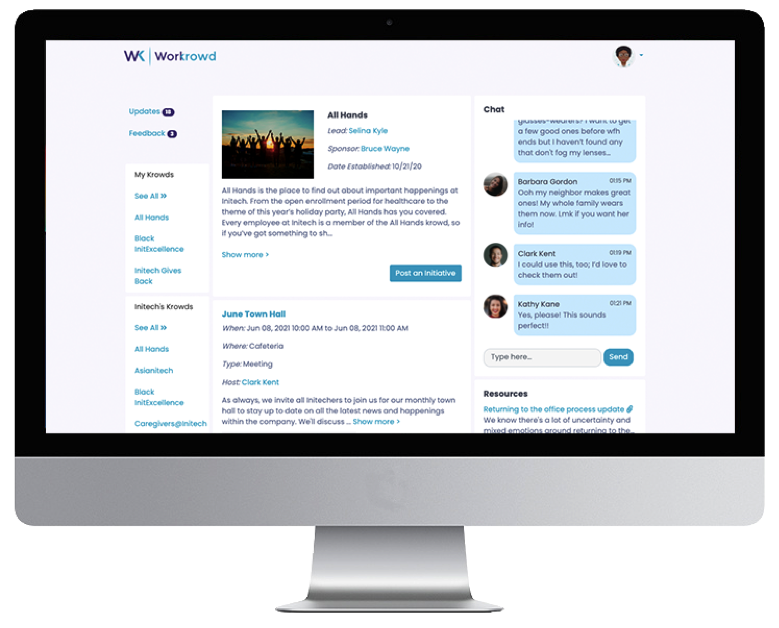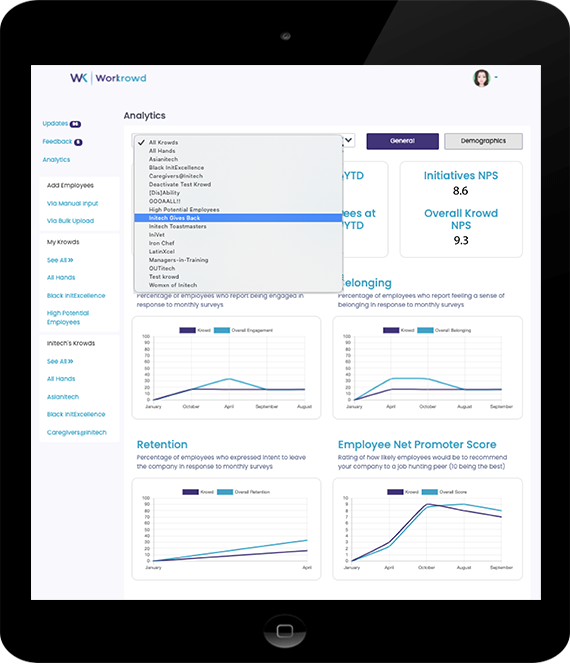Analytics make the business world go ‘round. Even if we dislike them, there’s no denying they help us make more informed decisions. From sales to marketing to finance, every department needs them. People teams are no exception; tapping into the right HR analytics can lead to happier employees, faster business growth, and increased revenue.
What should you be tracking, though?
Which metrics can give you new insights into your workforce? What will improve employees’ lives and the life of your business, too?
We highlight five HR analytics examples you should be paying attention to below.
Engagement rate for employee programming
Employee groups, programs, and events improve many aspects of your business, such as diversity and inclusion, retention, and employee wellbeing.
If employees aren’t participating in your programming, or you’re not sure what’s driving results, it’s time to expand your HR analytics.
Without real-time data on each of your employee experience initiatives, you won’t know how to maximize your impact. Is your programming reaching every team member? Are you offering the right types of groups, programs, and events? Is there anything missing?
Measuring the outcomes of your programming via once or twice yearly engagement surveys isn’t enough in today’s tough talent market. You need ongoing, real-time data to make the most of your employee experience investments.
Tools can help. Workrowd automatically collects engagement data for your programs and delivers it to you in easy-to-read dashboards. That way, you always know what’s working and where you can make improvements.
Retention/churn rate
Do you have a high churn rate? Or do employees stay and progress in your business?
This can be a tough stat to look at, especially if it’s high. Regardless, it’s an important metric to track as part of your HR analytics.
Some jobs and industries have a naturally higher employee turnover rate, such as sales or customer service. But if it’s a problem throughout the business, it may be a sign of a deeper, culture-based problem.
If there’s no room for employees to grow, or your workplace is toxic, this can increase your churn rate.
On the other hand, if employees feel comfortable and supported in their roles and like they’re making a real difference, they’re more likely to stay long-term.
If the issues you spot are department-specific, it’s worth considering…
Manager ratings
Sometimes, someone can be really great at one part of their job and terrible at another. Management roles are a great example. A lot of people can handle the paperwork part of management, but are terrible at the people management side.
I’ve worked for people who fall into this category, and it doesn’t make for a nice working environment. In fact, the stress of this management style is part of why I have chronic health issues now. So, the way your manager behaves really does matter.
Asking employees to fill in feedback forms then pass them to their line manager is a bonkers practice. Unfortunately, it’s one I’ve seen all too often. If someone is being bullied, belittled or micromanaged by their boss, are they really going to feel comfortable passing on said feedback to that person?
Employee feedback should be honest, and they shouldn’t feel afraid or intimidated by their manager into providing nicer feedback. How can you analyze results that don’t tell you the full story?
If someone—regardless of rank—raises issues about their manager, they should be taken seriously. A position of power shouldn’t make someone immune to consequences of bad behavior.
If you struggle to hire for your managerial roles, and that’s why you’ve settled for someone who can do half the role, consider what your compensation package looks like. Is the pay too low? Are you combining two completely different skill sets that don’t work in one role? Are you hoping for a unicorn but settling for a donkey?
Managers need to be able to manage people as well as handle paperwork. It shouldn’t be an either/or situation. Use your HR analytics to spot managerial issues before they cost you.
Sick days
How content are your employees, really? Do they enjoy their jobs, or are they doing it just to pay the bills?
If you notice a pattern where a lot of employees are out with conditions such as chronic back pain or stress, it’s time to look at your workplace and culture.
Are employees sitting in uncomfortable chairs, or at bad desks, that are damaging their backs?
Are they feeling pressured in their role, which is pushing their stress to unmanageable levels?
If you spot any patterns of recurring causes of illness—or an excessive amount of illnesses—talk to the employees who are experiencing these issues in a friendly, non-judgmental way. They’ll be more likely to open up to you if you speak to them like this. What they have to say may help you to unlock new insights that you hadn’t considered before.
Once you have this data, you can make changes to improve your workplace. You may need to make desk spaces more ergonomic, offer counseling to help employees manage stress, or look for ways to reduce their workload so that they don’t need to take so much time off.
Tracking sick time as part of your HR analytics approach ensures you can recognize issues with burnout and illness early enough to address them.
Down time
Do employees use their vacation days? When they take time off, do they feel guilty?
How about responding to emails outside of working hours? Do they feel unable to take time off because they have too much to do?
I once worked with someone who was so busy that by the end of the year, she had almost 20 vacation days left to use.
But it was Christmastime—she couldn’t take the time off then, either. It was her department’s busiest time of year.
Employees should never feel so overworked that they don’t believe they can take a break.
Breaks are an important part of us being able to work to the best of our capabilities. Without them, we’re less able to perform at our optimal physical or mental level, affecting our work and personal lives.
Tracking whether or not employees are taking PTO is an important piece of an effective HR analytics strategy.
Conclusion
These are often overlooked areas that will help you unlock new insights into your workforce. They’ll give you information on how employees really feel in their roles, and what your workplace culture is actually like.
The deeper you go into the data as part of your HR analytics, the more you’ll reveal and the more improvements you can make.
Are you interested in automating data tracking and HR analytics for your employee programming? If so, we’d love to chat.
Drop us a line at hello@workrowd.com or vist our site to learn how our one-stop tool suite can help you to streamline processes, boost engagement, empower employee leaders, and automate data tracking and HR analytics.

















